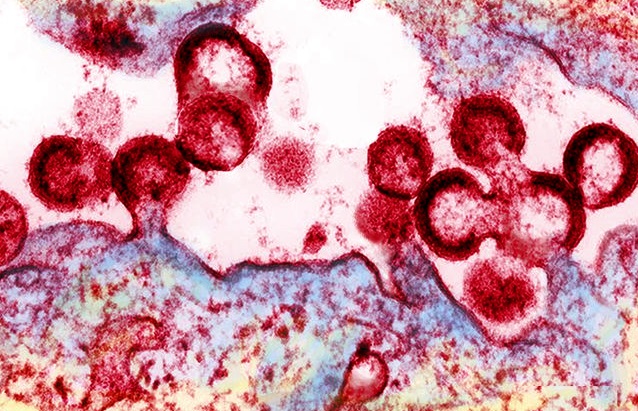Nikhil Prasad Fact checked by:Thailand Medical News Team Jan 20, 2025 3 months, 6 days, 6 hours, 44 minutes ago
Medical News: HIV-1, a virus that has caused a global health crisis for decades, continues to affect millions worldwide despite advancements in medical science. Nearly 39.9 million people were living with HIV/AIDS as of 2023. Combination antiretroviral therapy (cART) has been a cornerstone in managing the disease, allowing many individuals to lead longer, healthier lives. However, a complete cure for HIV-1 remains elusive due to the persistence of latent reservoirs where the virus lies dormant. These hidden sanctuaries within the body, including immune cells and tissues like the brain, evade current therapies, presenting a major obstacle to eradication.
 Kinases in Extracellular Vesicles of HIV Infected Cells Impact Bystander Cells
Kinases in Extracellular Vesicles of HIV Infected Cells Impact Bystander Cells
Recent research has revealed that even under effective cART, transcriptional activity can occur, producing viral RNA in low amounts. This
Medical News report delves into groundbreaking findings on how extracellular vesicles (EVs), specifically exosomes released by HIV-1-infected cells, carry kinases that influence the behavior of neighboring, uninfected cells.
What Are Extracellular Vesicles?
Extracellular vesicles are tiny, membrane-enclosed particles released by cells, playing a key role in intercellular communication. They carry a rich cargo of proteins, lipids, and RNA, influencing the activities of recipient cells. American researchers from George Mason University, the University of Alabama at Birmingham, and the National Center for Biodefense and Infectious Diseases explored the impact of kinases within EVs from HIV-1-infected cells on bystander cells. This study highlights a novel pathway that could further explain the persistence of HIV-1 despite aggressive treatment.
Key Findings of the Study
The researchers identified significant differences in the kinase composition of exosomes derived from uninfected versus HIV-1-infected cells. Using advanced phospho-kinase profiling, the team discovered that three kinases - cyclin-dependent kinase 10 (CDK10), glycogen synthase kinase-3 beta (GSK3β), and mitogen-activated protein kinase 8 (MAPK8) - were enriched in exosomes from HIV-1-infected cells.
-CDK10: This kinase regulates transcription factors like ETS2, which are essential for activating HIV-1-related genes.
-GSK3β: Known for its role in Tat-mediated transcription, the inhibition of GSK3β has been shown to significantly reduce viral replication.
-MAPK8: Part of the MAP kinase pathway, this enzyme influences the transcriptional activity of key HIV-1-related factors such as activator protein 1 (AP-1).
These kinases were not only present in the exosomes but were also found to be biologically active, capable of phosphorylating substrates and altering cell cycle dynamics in bystander cells.
How Bystander Cells Are Affected
Exosomes from HIV-1-infected cells
were shown to induce functional changes in uninfected bystander cells. The kinases within these exosomes modulated the phosphorylation of cellular substrates, resulting in alterations to cell cycle dynamics. For example, CDK10, GSK3β, and MAPK8 were implicated in pathways that enhance viral transcription and disrupt normal cell processes. These findings suggest that the cargo of exosomes could amplify the virus's ability to persist and evade immune responses, even in cells not directly infected by HIV-1.
Implications for HIV-1 Pathogenesis
The discovery of active kinases in exosomes provides new insights into how HIV-1 manipulates its environment to sustain infection. By altering the behavior of neighboring cells, these exosomes could contribute to viral reservoirs' persistence and the failure of current therapies to completely eradicate the virus. The study's authors propose that targeting exosome-associated kinases may represent a promising therapeutic strategy to complement existing cART regimens.
Conclusions and Future Directions
The study offers a groundbreaking perspective on the role of extracellular vesicles in HIV-1 pathogenesis. It highlights how HIV-1-infected cells can influence their microenvironment through exosome cargo, particularly kinases like CDK10, GSK3β, and MAPK8. By phosphorylating key substrates and altering cell cycle dynamics, these exosomes may help the virus maintain its foothold, even under stringent antiretroviral therapy.
Future research should focus on developing therapies that target these exosome-associated pathways. For instance, inhibitors of the identified kinases could be explored to prevent the exosomal manipulation of bystander cells. Such approaches could significantly enhance the efficacy of existing HIV-1 treatments and bring us closer to achieving a functional cure.
The study findings were published in the peer-reviewed journal: Cells.
https://www.mdpi.com/2073-4409/14/2/119
For the latest HIV News, keep on logging to Thailand
Medical News.
Read Also:
https://www.thailandmedical.news/news/the-lectin-microvirin-shows-potential-in-hiv-1-treatment
https://www.thailandmedical.news/news/natural-indoles-from-the-gardneria-multiflora-makino-plant-emerging-as-potential-antiviral-agents-against-hiv-and-hcv
https://www.thailandmedical.news/news/43-percent-of-adults-living-with-hiv-developed-long-covid-after-exposure-to-sars-cov-2
https://www.thailandmedical.news/news/elevated-growth-differentiation-factor-15-may-hold-answers-for-hiv-neurocognitive-decline
https://www.thailandmedical.news/news/hiv-news-scientists-discover-naturally-occurring-antiviral-concanamycin-a-that-can-possibly-cure-not-just-treat-hiv
https://www.thailandmedical.news/news/sars-cov-2-reactivates-latent-hiv-and-can-influence-hiv-disease-progression
https://www.thailandmedical.news/articles/hiv-aids
